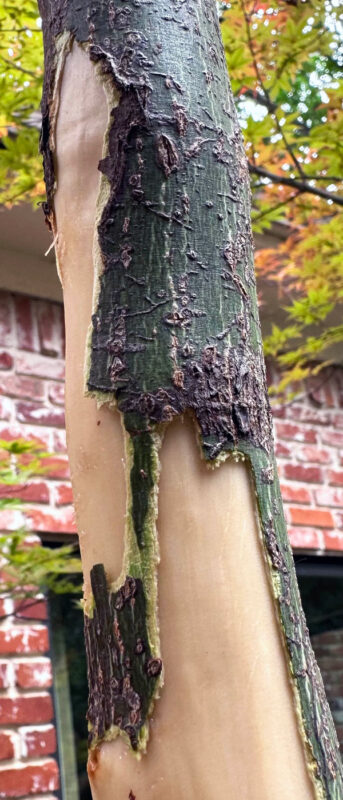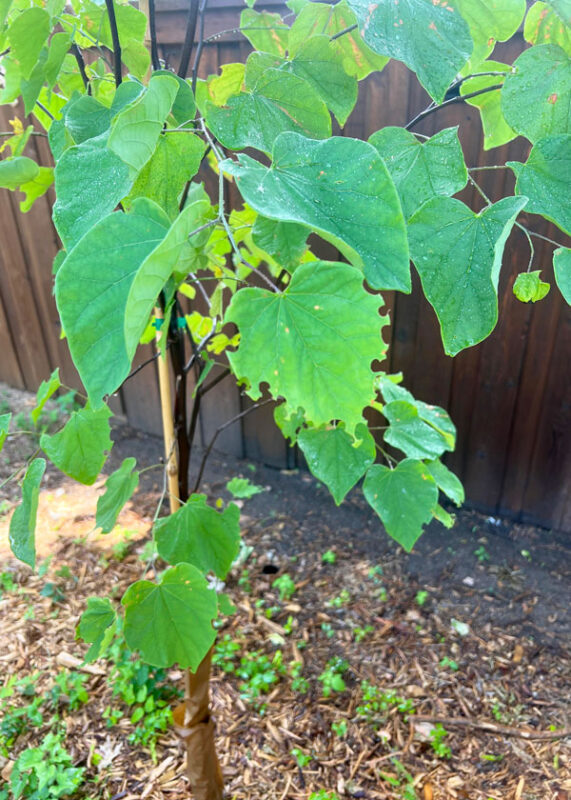Q&A – Ask Neil: June 12, 2025
(Please read these instructions carefully.)
Before you post your question, please look at recent issues to see if someone else has already asked it. You might find your answer there.
How to submit your question…
(Note: You may need to allow a pop-up window to come up in order to get the link for sending your photo(s). If you have already submitted your question and didn’t see the pop-up window, please click here.)
• Click the link provided below to post your question. After you submit your question, a new window will pop up giving you the address to which you can e-mail a SHARP, HIGH-RESOLUTION PHOTO to accompany your question. Please DO NOT SEND THUMBNAIL PHOTOS in case I need to zoom in to see things.
• Click here to post your question.
• Please ONLY POST YOUR QUESTION ONE TIME. We can only accept a set number of questions each week, and when we get duplicates it costs other people their chances.
• One question per reader, please.
• Please use this only for posting questions – not for standard emails.
• Watch for your answer in the following week’s e-gardens.
• I choose those of greatest general interest. For example, plant IDs seldom make the cut.
• I must have your first name or initials.
• I must have your city or county. (Texas is a very large state.)
QUESTION 1
IS THERE HOPE FOR MY JAPANESE MAPLES?
Question: For the first time in 35 years of growing numerous Japanese maples on my property, at least one squirrel has gone crazy in the last couple of days taking the bark off around 15 of my 21 maples. These photos are of the worst. Is there any hope for survival? Michael M., Plano.
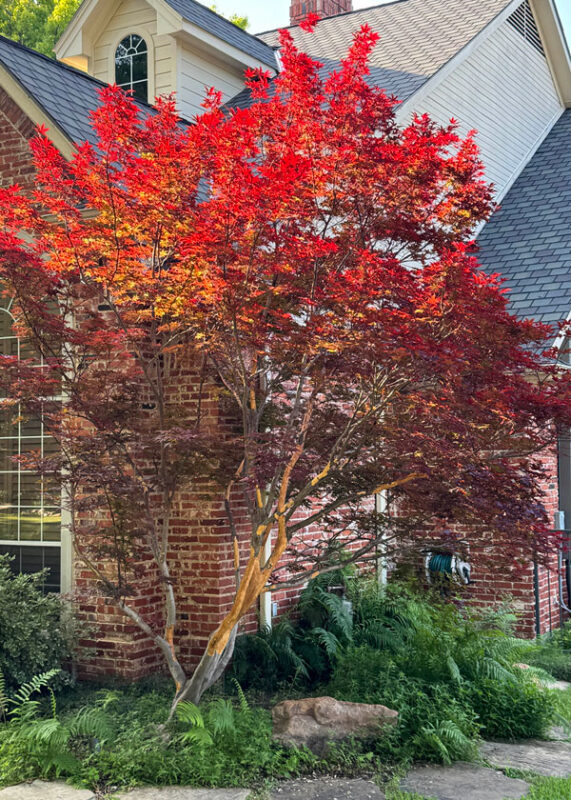
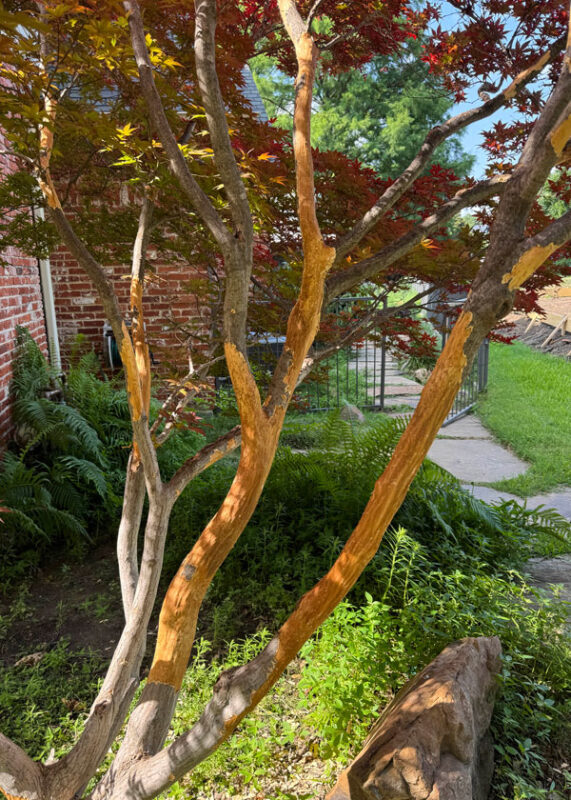
Answer: Oh, this breaks my heart. When bark is lost the tissue just beneath the bark, the phloem, is also lost. That’s the cylinder of tissue that carries sugars manufactured in the leaves down to the roots. If the bark is lost all the way around the trunk at a given spot, the damage can be extreme. That’s why sun scald does so much damage to young maples, and why I’m concerned about your trees.
If you have an arborist who has done superior work for you in the past, get them out on an emergency basis. This truly is one. If you need a referral, I will tell you that the men and women from our advertiser, Arborilogical Services, are the best I have ever known. They are near you, and they are highly trained with 44 years in the business. I would call them as soon as you finish reading this. Hopefully most, if not all the trees can be saved.
Do not apply pruning sealant and do not wrap the trunks. I would suggest investing immediately in Havahart humane traps from a farm supply store. I have had good luck in catching raccoons and possums in them.
Please take weekly photos and keep us updated. Very good luck with your trees. It’s obvious how much care you give to your landscape!
Note: I actually sent this reply to Michael last Friday after receiving his question. This one could not wait.
QUESTION 2
WHAT CAN YOU TELL ME ABOUT SPRUCE FOR CONTROL OF NUT GRASS?
Question: I have used Image for several years on nut grass. This year there was no visible Image damage (perhaps because of May rains?). I succumbed to advertising for Spruce. In 24 hours, visible nut grass damage. Dead in a week. What info do you have about Spruce? Margaret S., Fort Worth.
Answer: I have not used Spruce firsthand, so you are ahead of me there. However, in doing background checking for you I see that it is non-selective, meaning that it’s going to kill turfgrass and other vegetation on which it is sprayed, so you need to be very careful where you apply it. You also need to wait for longer than a week to make your decision on its effectiveness. Things that give fast results often only “burn” the tops back. They then come back from their roots.
Without going into specifics, I read the Spruce website information. I felt like it sounded a bit elementary in some of its terminologies.
As for the unsatisfactory results with Image, it might have been due to rains, but then again, you’re supposed to water it in deeply. I wonder if you had the same product you’ve used in the past. You might check the label.
From what I read, I’ll stick with Image for control of nutsedge at this point.
QUESTION 3
WHEN AND HOW SHOULD WE PRUNE OUR TRUMPETVINE?
Question: When and how is the best way to prune a trumpet vine? We have one that covers our arbor, and every time we’ve tried to cut it back to keep it out of the gutters or just in control, those parts die off. Now it’s in need of some major pruning. Paula W., McKinney.
Answer: Jokes on me! I thought you had not attached a photo, so I went ahead and answered your trumpet vine question just as I have scores of others over the years.
Then, as I was getting all the photos ready for inclusion, I found yours. Lovely arbor! But, that’s not trumpet vine on it. That’s crossvine (Bignonia capreolata), probably a cultivar known as ‘Tangerine Beauty.’ It’s a beautiful and compelling plant when you see it in bloom in garden centers in spring. The species is native to the southeastern part of the United States from the Atlantic Ocean clear into the East Texas Piney Woods. (https://www.fs.usda.gov/wildflowers/plant-of-the-week/Bignonia_capreolata.shtml)
However, as with so many plants native to that area, it does not thrive in the western two-thirds of Texas due to the highly alkaline soils and equally alkaline irrigation water. You’ll see iron deficiency and you’ll also see dieback just like your plant is experiencing. Pruning out the dead wood isn’t going to help you much. Remaining stems, if they grow any new growth at all, are likely to be sparse and unsightly.
It’s probably time to take it out entirely and replace it with some other shade-tolerant vine that won’t overgrow the support you have for it.
I would suggest two fairly common ones. (Choose one.) Carolina jessamine with its glossy dark green evergreen leaves and highly fragrant yellow spring blooms or regular English ivy.
Carolina jessamine twines, so it will climb on its own. It’s also a refined grower, so it would never overwhelm the arbor. English ivy is bold and handsome. It clings as it climbs. You would have to prune its growth back every couple of years so it wouldn’t start climbing your house. Both are completely tolerant of shade.
QUESTION 4
HOW CAN I HELP MY CRABAPPLE AND SUNSHINE LIGUSTRUM?
Question: Two plants in my landscape are distressed. One is a crabapple tree and the other a Sunshine ligustrum. My water meter shows that they are both fully watered. I have watered and fertilized per your recommendations before the rains. What suggestions do you have? Jan H., The Colony.
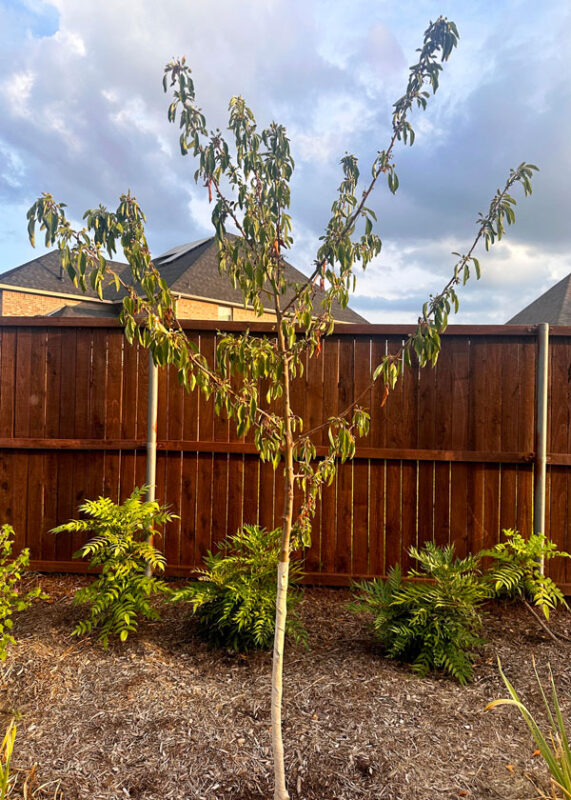
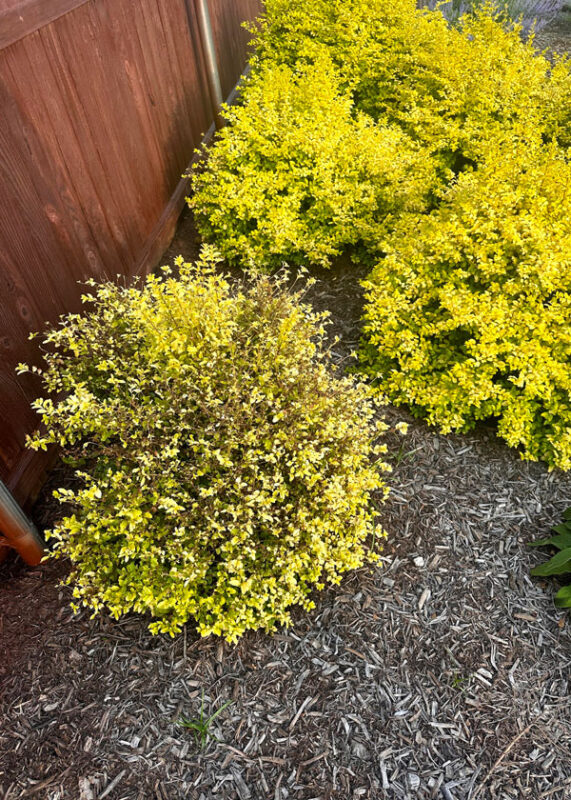
Answer: I can almost guarantee you that the crabapple has succumbed to the soilborne fungus known as cotton root rot. It is the reason there is almost no cotton grown in the Blackland Prairie any longer. It attacks perhaps 80 percent of our landscape species. Some are much more susceptible than others, and apples and pears are at the top of the list. Its hallmarks are that it will remain dormant in the soil for years and then suddenly will kill a host plant within just a few days. There is no prevention and there is no cure. If you’re looking for a small flowering tree that would be resistant or immune to the disease, I’d suggest a redbud or Little Gem southern magnolia.
As for the Sunshine ligustrum, I guess that could also be cotton root rot. If so, look for it to spread to the other plants nearby. However, it doesn’t look quite right. If it were CRR the leaves probably would have turned brown and hung on the twigs for weeks. This plant looks bleached, as if it didn’t have enough chlorophyll and just sunburned after the rains let up. This plant is quite variable. The variegation is unstable, and its winter hardiness is undependable in the northern half of the state.
QUESTION 5
DO I NEED TO WRAP THE TRUNKS OF MY YOUNG CHINESE PISTACHIOS?
Question: I have two volunteer Chinese pistachio trees. One appeared three years ago and the other last summer. I understand I should wrap pistachio trees for several years when I buy them at a nursery. Should I also wrap the trunks of these volunteer trees? M.A.C., Tarrant County.
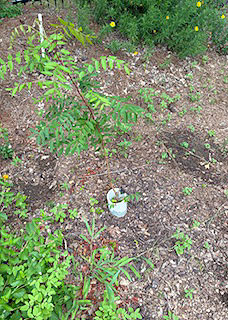
Answer: No. First of all, they’re too small. You’d probably break them if you tried to wrap them. Second, these trees have grown up in full sun, so they’re already acclimated to the sun. The difference is that nursery-grown trees are produced pot-to-pot for their first several years. They shade one another in the process. Then suddenly they are thrown out into the sun when we plant them into our yards.
QUESTION 6
DO MY CARISSA HOLLIES NEED MORE SUN?
Question: These Carissa hollies were planted three years ago. The middle one was replaced last year. I know to keep them hand watered. They get about 3-4 hours of sun per day. The one on the right gets the most sun. Should I move them to a sunnier place? Terry C., Dennis, Parker County.


Answer: Not at all. My best Carissa hollies are in a spot where they get no direct sun at all. They’ve been there for 30 years. I know you said you watered them by hand last year, but I’d be willing to bet that the middle plant got too dry one or more times during that year. They don’t wilt like other plants, so it’s easy for it to happen and we don’t even notice it. There were some very dry times last year. It looks like the grass immediately adjacent has also gotten dry. I would replant yet one more time, and I’d even put one more on the back side, closer to the house. Put a couple of gallons of water on each plant every day until Thanksgiving. Resume next spring.
QUESTION 7
WHAT IS EATING THE LEAVES OF MY REDBUD?
Question: What is eating the leaves of my redbud? I’ve had it in the ground about six weeks. I don’t see any insects on it. It looks like bite marks along the edges. Ken H., Frisco.
Answer: This is my favorite insect. It’s the work of the leaf cutter bee. The female uses her very sharp mouth parts to cut these semi-circular pieces from the edges of the leaves. She then transports them to a dormant water faucet or downspout to build her nest. She does not eat the leaf parts, and she is only on the tree for a few moments. You will see her damage on roses, redbuds, and several other plant species. Since she is not feeding on the plant tissues, and since she is not there very long, there is no spray that will help with her. The good news, however, is that she does no major damage to the affected plants. Just sit back and admire her ingenuity. You may never see the damage again.

